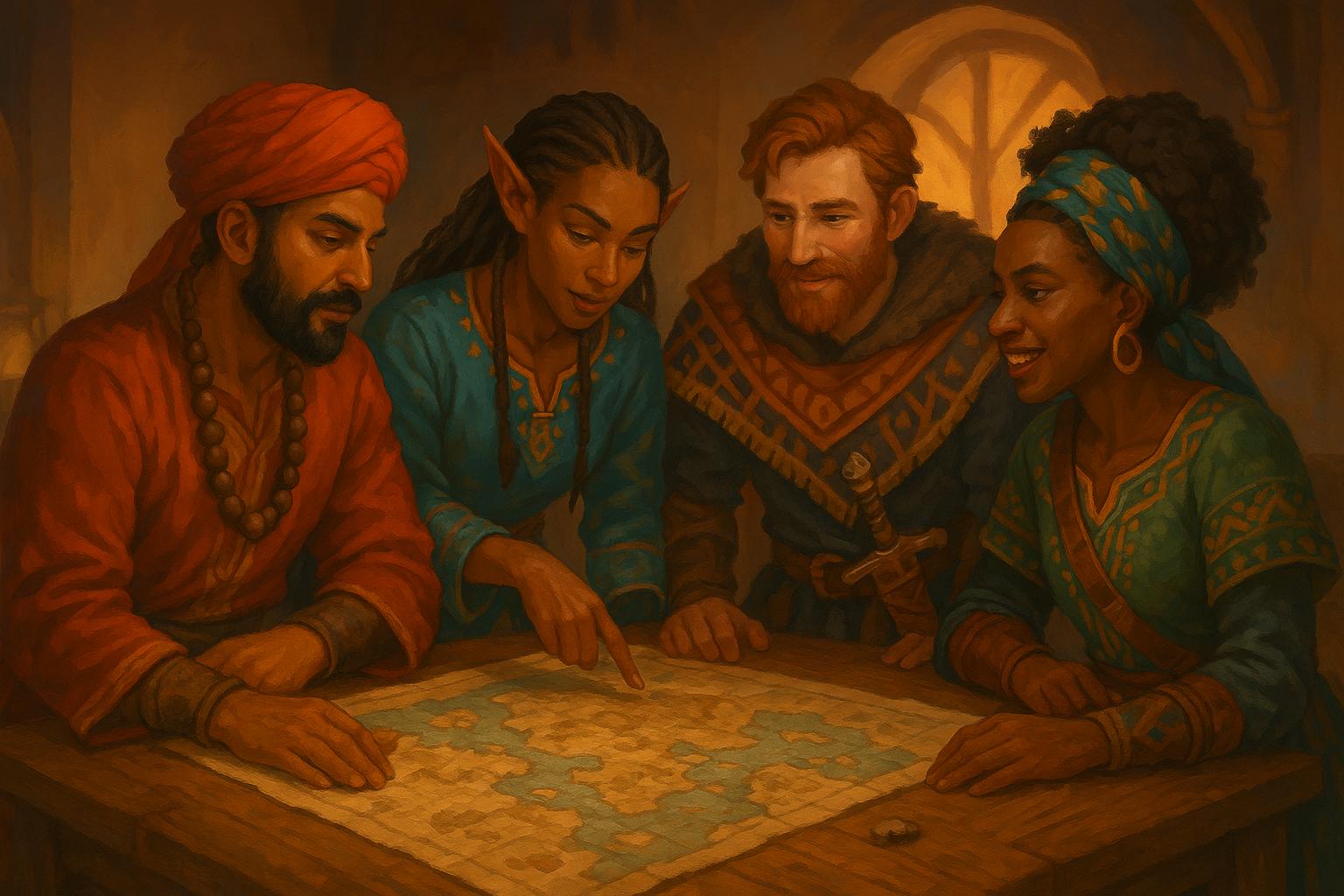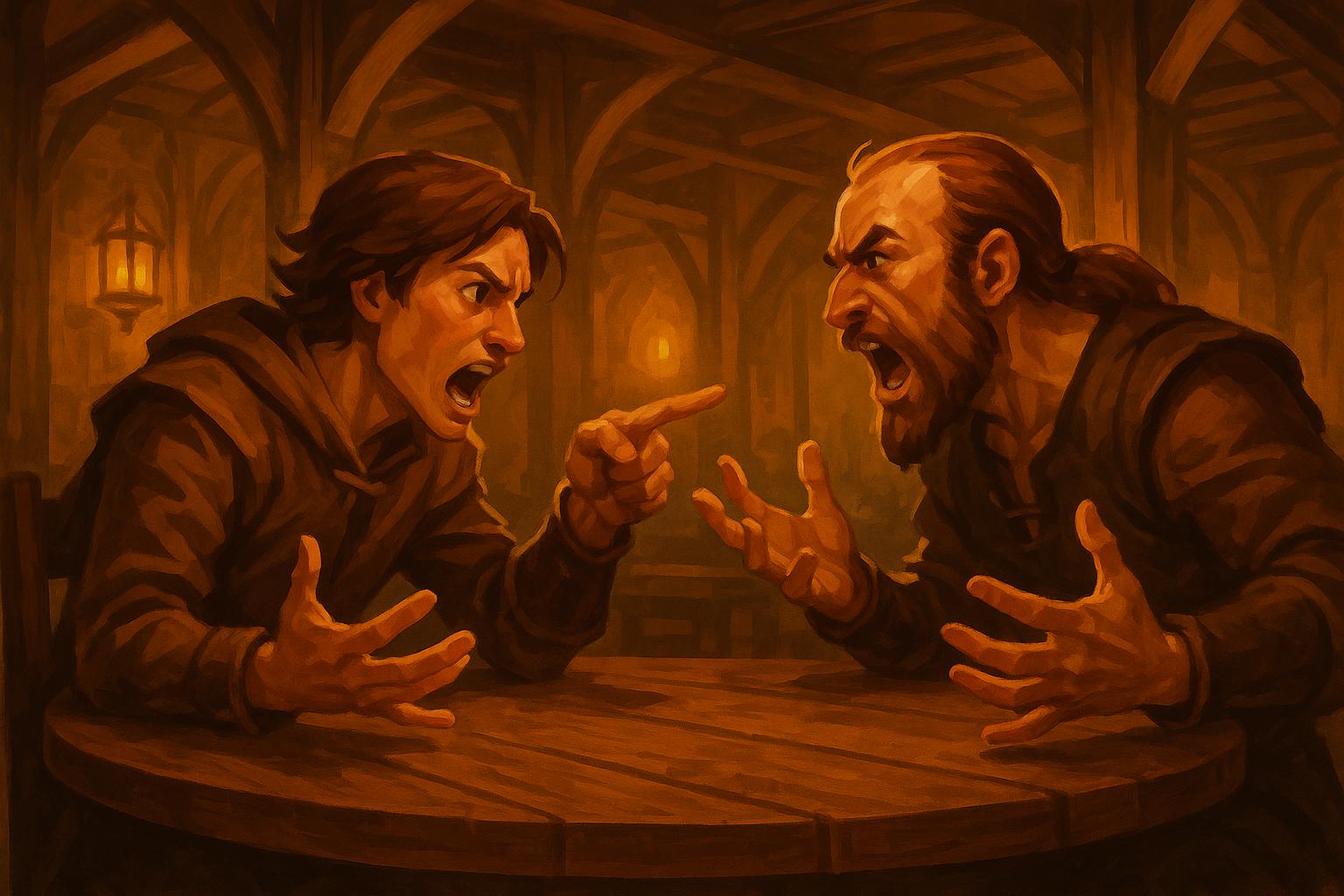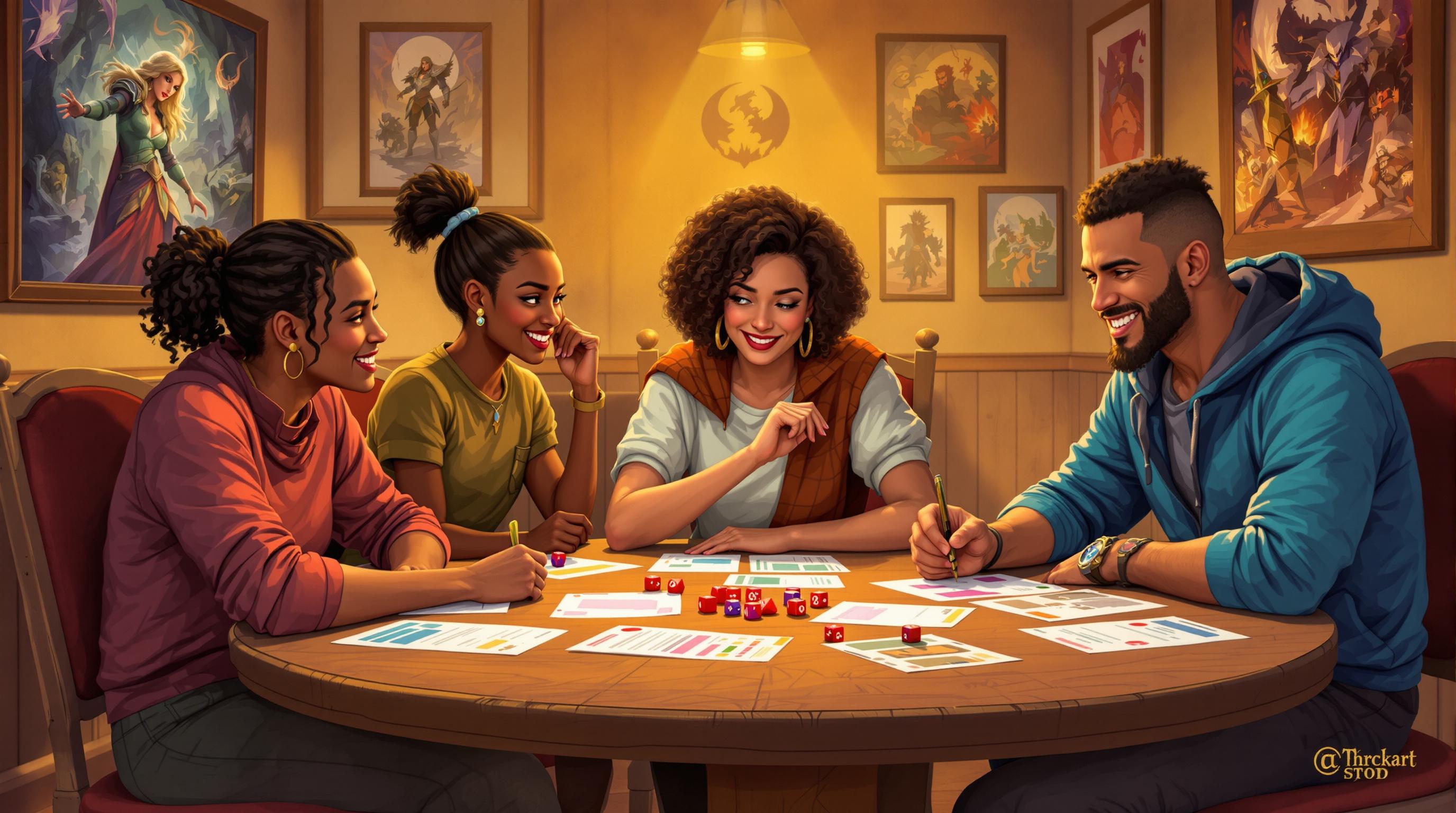Card-based tabletop role-playing games (TTRPGs) are transforming the way people play, offering a fresh alternative to dice-based systems. Instead of relying on random rolls, players use cards to make decisions, manage resources, and shape stories. This approach blends strategy with storytelling, giving players more control over outcomes. Here's why card-based TTRPGs are gaining attention:
- Player Control: Cards allow for strategic decision-making, unlike the randomness of dice rolls.
- Dynamic Gameplay: Drawing cards changes probabilities mid-game, creating a unique flow.
- Familiarity: Many players already know how to use cards, making these games easier to learn.
- Shorter Sessions: Games often require less setup and are quicker to play, fitting busy schedules.
- Popular Titles: Games like Through the Breach, Deadlands, and Savage Worlds showcase how cards enhance gameplay.
Whether you're a beginner or an experienced player, card-based TTRPGs offer a refreshing way to enjoy immersive storytelling with less complexity and more strategy.
14 Great Tabletop Roleplaying Games That Use a Standard Deck of Playing Cards, Card Driven RPGs.
How Card-Based Mechanics Work Differently from Dice Systems
Examining the differences between card-based and dice-based mechanics sheds light on how each system shapes the gaming experience. While both inject an element of randomness, the way they function influences probability, strategy, and overall gameplay in unique ways.
Main Differences in Game Mechanics
The biggest distinction lies in how each system handles probability. Dice rely on independent probabilities, meaning each roll is unaffected by previous outcomes. For example, rolling a 20 on a d20 doesn’t change your odds of rolling another 20 - it’s always 5%.
Card-based mechanics, however, operate on dependent probabilities. Every card drawn changes the odds for future draws. In a standard 52-card deck, pulling an ace reduces the chance of drawing another ace from 7.7% to 5.8% because the deck "remembers" what’s already been played. This creates a dynamic where players can adjust their strategies based on what’s left in the deck.
This "memory" aspect also introduces an element of resource management. Players can hold onto specific cards for pivotal moments, turning randomness into a tool for strategic decision-making.
Take Savage Worlds as an example: cards are used to determine initiative, creating a clear, ordered sequence that’s faster and easier to follow than rolling dice. This transparency simplifies turn management and keeps gameplay flowing smoothly.
These mechanics open the door to more strategic choices, particularly around managing hands and decks.
How Cards Change Player Decision-Making
The differences in probability also shift how players make decisions. With cards, hand management becomes crucial. Players must weigh the benefits of using strong cards immediately versus saving them for critical moments. Combined with mechanics like deck building and drafting, this adds layers of strategy, enabling players to influence their odds over time.
For example, with four players holding seven cards each from a shared deck, the probability of drawing any specific card during a session is around 44%. This gives players meaningful odds to consider when planning their moves.
Cards also introduce a layer of secrecy. Unlike dice rolls, which are immediately visible, cards can be kept hidden until played. This opens the door for bluffing and surprise tactics, adding depth to the narrative and creating opportunities for more dynamic interactions.
Additionally, cards bring design flexibility. Their numbers, suits, colors, and symbols allow for complex mechanics where a single draw can affect success levels, trigger special abilities, or introduce unexpected twists. Players can even "bank" valuable cards to offset potential setbacks.
Together, these features combine strategy and storytelling, delivering a gaming experience that feels fresh and engaging while offering players more control over their fate.
Top Card-Based TTRPGs and What Makes Them Stand Out
Building on the evolving mechanics we’ve touched on earlier, card-based tabletop RPGs (TTRPGs) showcase a world of creativity and accessibility. These games span a variety of genres, from Western-themed adventures to steampunk mysteries, offering unique ways to enhance storytelling while simplifying gameplay beyond the traditional reliance on dice.
Examples of Well-Known Card-Based TTRPGs
- Through the Breach: Step into a steampunk world as "The Fated", characters who use playing cards along with their stats to shape their destinies during gameplay. This game combines rich storytelling with a card-driven mechanic that feels both intuitive and immersive.
- Deadlands: Dive into the "Weird West", where supernatural elements meet the rugged frontier. Players use cards as part of a system that pits them against dark forces in pursuit of power, creating a blend of eerie storytelling and strategic play.
- Savage Worlds: Designed as a versatile system, this game adapts to a wide range of action and adventure settings. Playing cards play a key role in determining initiative during combat, adding a layer of unpredictability to battles.
- Castle Falkenstein: This game merges steampunk and fantasy, using playing cards to resolve conflicts. Its mechanics emphasize storytelling and create a seamless connection between narrative and gameplay.
- For the Queen: A standout for those who love narrative-driven experiences, this game revolves around prompts that guide you through a shared journey of loyalty, conflict, and discovery as you serve your queen.
These games highlight the flexibility of card mechanics, catering to a range of play styles - from rules-light, story-focused adventures to more tactical, structured gameplay.
How to Find More Card-Based TTRPGs
The titles above are just the tip of the iceberg when it comes to card-based TTRPGs. To dive deeper into this genre, check out the TTRPG Games Directory. It’s a fantastic resource for discovering both classic and indie card-based games. With filtering options, you can narrow your search to games that feature mechanics like "hand management", "deck building", or "card drafting."
When exploring, keep an eye out for games that incorporate playing cards, tarot cards, or even custom decks. Indie designers, in particular, are pushing boundaries by blending traditional card game elements with roleplaying mechanics, resulting in some truly creative offerings.
User reviews and ratings on the directory can also guide you toward games that suit your group’s preferences. Whether you’re after a narrative journey or a more tactical, combat-focused system, there’s a card-based TTRPG out there for you.
Pros and Cons of Card-Based TTRPGs
Now that we've explored how card-based mechanics work, let's weigh their practical pros and cons. These systems offer a unique blend of strategy and storytelling, distinct from traditional dice-based games. Here's what you need to know to decide if they're a good fit for your group.
Comparison Table: Benefits and Drawbacks
| Benefits | Drawbacks |
|---|---|
| More Player Agency – Players can select which card to play, giving them more control over outcomes compared to the randomness of dice rolls. | Complex Probability – As cards are drawn, the odds shift, making probability harder to calculate compared to dice. |
| Strategic Resource Management – Cards encourage thoughtful decision-making since each card played is no longer available. | Limited Options – Some players may feel constrained by the finite choices in their hand. |
| Moderated Outcomes – Card systems reduce extreme results by adjusting odds as the deck is used. | Setup Complexity – Many card-based games require extra components like custom decks or tokens. |
| Detailed Information – Cards can combine numbers, suits, and special abilities, offering more depth in a single draw. | Less Realistic Simulation – Cards don't replicate real-world probabilities as naturally as dice. |
| Enhanced Storytelling – Cards can represent traits, events, or story elements, adding depth to roleplaying. | Predefined Results – Poorly designed systems can make outcomes feel forced or predetermined. |
The evolving probabilities in card-based systems add a layer of strategy. For instance, drawing a card is like rolling a 52-sided die, but unlike dice, the odds change as cards are removed from the deck. This dynamic can lead to thoughtful, engaging gameplay but might not suit everyone.
What Players Should Consider
Beyond the mechanics, the success of a card-based TTRPG depends on how well it aligns with your group's style and preferences. Here are some key factors to think about:
Social Interaction and Storytelling play a big role. Groups that love collaborative storytelling and shared decision-making often thrive with card-based systems. The strategic nature of choosing cards encourages discussion and teamwork, making it ideal for socially driven players.
Accessibility for New Players is another advantage. Card-based games are often easier for beginners to grasp. Instead of juggling multiple dice and modifiers, new players can quickly pick up the basics by playing from a hand of cards.
Time and Preparation are important considerations for busy groups. Card-based systems typically require less setup, making them perfect for spontaneous sessions or players with limited free time.
Control vs. Randomness is a key preference to evaluate. Players who enjoy having more control over outcomes tend to favor card systems. As Cannibal Halfling Gaming points out:
Playing cards are not designed to model probability, they're designed to distribute numerical outcomes to players who must then use those outcomes in an optimal way to win the game they're playing.
Session Length and Flexibility are additional perks. Card-based games often work well for shorter sessions without sacrificing narrative depth. The natural pacing of drawing cards and managing hands creates story beats that fit into tight schedules.
Ultimately, choosing between cards and dice depends on what your group values most. If your players lean toward collaborative storytelling and strategic gameplay, card-based systems might be a hit. However, if they prefer the unpredictable thrill and detailed simulation of dice rolls, a traditional system may be the better option.
sbb-itb-b8b00a5
Why Card-Based TTRPGs Work Well for New Players
Card-based tabletop role-playing games (TTRPGs) have carved out a niche as an inviting entry point for those new to the world of tabletop gaming. In the United States, where the hobby continues to expand, these games combine familiar mechanics, quick setup, and adaptable gameplay. This mix makes them especially appealing to first-time players who might find traditional, dice-heavy RPGs a bit daunting.
Easier Entry for Beginners
One of the standout features of card-based TTRPGs is their ease of use. Compared to traditional systems, these games often come with simpler rulebooks and rely on cards - something most people already know how to use. This cultural familiarity helps new players pick up the basics quickly. Plus, the setup is minimal. Usually, all it takes is opening the box and shuffling the deck, which eliminates many of the hurdles that can discourage beginners.
Another advantage is the flexibility in player count. Card-based systems often work for solo players or small groups, making them a great choice for those who don’t have a large gaming circle. And unlike dice, which can feel unpredictable, cards offer more control. Helio from Burning Games explains:
"The first thing to go were the dice: they add a randomizer element that, in our eyes, gets in the way of decision-making".
This added control allows new players to focus on strategy and storytelling without feeling overwhelmed by chance. These features align perfectly with the growing demand for accessible gaming experiences in the U.S.
Appeal in the U.S. Gaming Market
The appeal of card-based TTRPGs goes beyond just beginners - they’re also gaining traction with a broader audience in the U.S. The gaming market has shown a strong interest in tabletop games that are easy to pick up, with TTRPG sales jumping 31% in 2021. This growth has been fueled in part by a younger demographic; for instance, in 2020, 24% of D&D players were between 20 and 24 years old.
Social connection plays a big role in their popularity. Many players find that tabletop role-playing offers a sense of control and creativity that’s hard to replicate elsewhere. Abigail Dela Cruz, a college freshman studying interior design, shares:
"When you go to D&D, or like any tabletop roleplaying game, you have more control over something that's like really fantastical. I feel like that's a major factor in what helps people in terms of … mental wellness".
Card-based systems, with their faster gameplay and shorter sessions, are particularly well-suited to American preferences. Games like Archwynd demonstrate how these systems can fit into busy schedules without sacrificing the fun.
Conclusion
Card-based TTRPGs are shaking up the world of tabletop gaming, offering a fresh way to dive into role-playing adventures. Whether you're new to the hobby or a veteran looking for something fresh, these games are worth checking out. With streamlined gameplay, quick setup, and sessions that last just 20–40 minutes, they fit perfectly into the fast-paced schedules of many Americans. This simplicity makes them easy to pick up and enjoy.
These systems also work as great entry points into the RPG world. They introduce key concepts like armor class, hit points, and magical effects in a way that feels intuitive and approachable. Perfect for family game nights or casual hangouts, they remove the intimidation factor of dense rulebooks and hours of preparation, making them an excellent choice for newcomers and seasoned players alike.
What’s more, card-based TTRPGs encourage creative storytelling and collaboration while keeping the gameplay structured. The deck mechanics add just the right amount of randomness to create suspense, without the chaos that dice rolls can sometimes bring. This balance gives players more control over their decisions, leading to richer and more engaging gameplay.
Why You Should Try Card-Based TTRPGs
Now is the perfect time to explore card-based TTRPGs. As the tabletop gaming scene continues to grow, these games are becoming increasingly popular, especially among younger players who appreciate their accessibility. Whether you’re drawn to the fantasy worlds of Archwynd or the inventive mechanics of Through the Breach, there’s likely a card-based game that matches your style and interests.
To get started, check out resources like the TTRPG Games Directory to find games that fit your group size, favorite themes, and experience level. One of the best parts? These games have a low barrier to entry - just open the box, shuffle the cards, and you’re ready to play. This ease makes them a fantastic way to dip your toes into tabletop role-playing or add variety to your game nights.
Don’t let their simplicity fool you. These games pack a punch with high replay value, consistent pacing, and a level of player control that rivals traditional dice-based systems. They’re not a step back from classic RPGs but a step forward, making the hobby more accessible and enjoyable for everyone. By diving into card-based TTRPGs, you’ll join a growing community of players who value quick, strategic, and story-rich gameplay.
FAQs
How do card-based TTRPGs give players more control compared to traditional dice-based games?
Card-based TTRPGs shift the focus from unpredictable dice rolls to strategic decision-making, giving players more control over the game. Instead of leaving outcomes to chance, players draw and play cards from their hand, allowing them to carefully plan their moves and make deliberate choices. This approach introduces a more structured and strategic element to the gameplay.
By managing their cards, players can respond to different challenges in unique ways, tailoring their strategies to fit the situation. This not only minimizes the role of luck but also encourages creative thinking and problem-solving. For those who enjoy games that reward thoughtful planning, this system offers a more engaging and personalized experience.
What are some tips for effectively managing cards in a card-based TTRPG?
Managing Cards in a Card-Based TTRPG
Using cards effectively in a card-based tabletop role-playing game (TTRPG) can make your sessions smoother and more engaging. Here’s how to get the most out of them:
- Add Variety to Gameplay: Cards can be a fun way to introduce random elements into your game. Use them to generate things like NPC names, weather changes, or unexpected events. This not only keeps the story fresh but also encourages creative storytelling.
- Stay Organized: Create reference or status cards for important characters and key game details. These quick-access tools make it easy for players to find the information they need without interrupting the flow of the game. It’s a simple way to cut down on downtime and keep everyone focused.
- Keep Things Fair and Exciting: Regularly shuffle your deck and draw cards face-down during play. This ensures an element of surprise and keeps the game unpredictable, offering strategic challenges for all players.
By integrating these techniques, you can elevate your card-based TTRPG experience while keeping the gameplay dynamic and fair.
Are card-based tabletop RPGs good for beginners?
Card-based tabletop RPGs are an excellent starting point for newcomers! These games often come with straightforward rules and easy-to-grasp mechanics, making them ideal for players without any prior experience. Titles like For the Queen or Arkham Horror: The Card Game emphasize storytelling and creativity over dense rulebooks, which helps create a welcoming atmosphere for beginners.
What’s more, card-based systems simplify gameplay by minimizing the need for lengthy preparation or constant dice rolling. This streamlined approach lets players dive in quickly and enjoy engaging, story-driven adventures without feeling bogged down by complexity. Whether you're stepping into the world of tabletop RPGs for the first time or simply want to try something new, card-based games offer an inviting and exciting experience!


